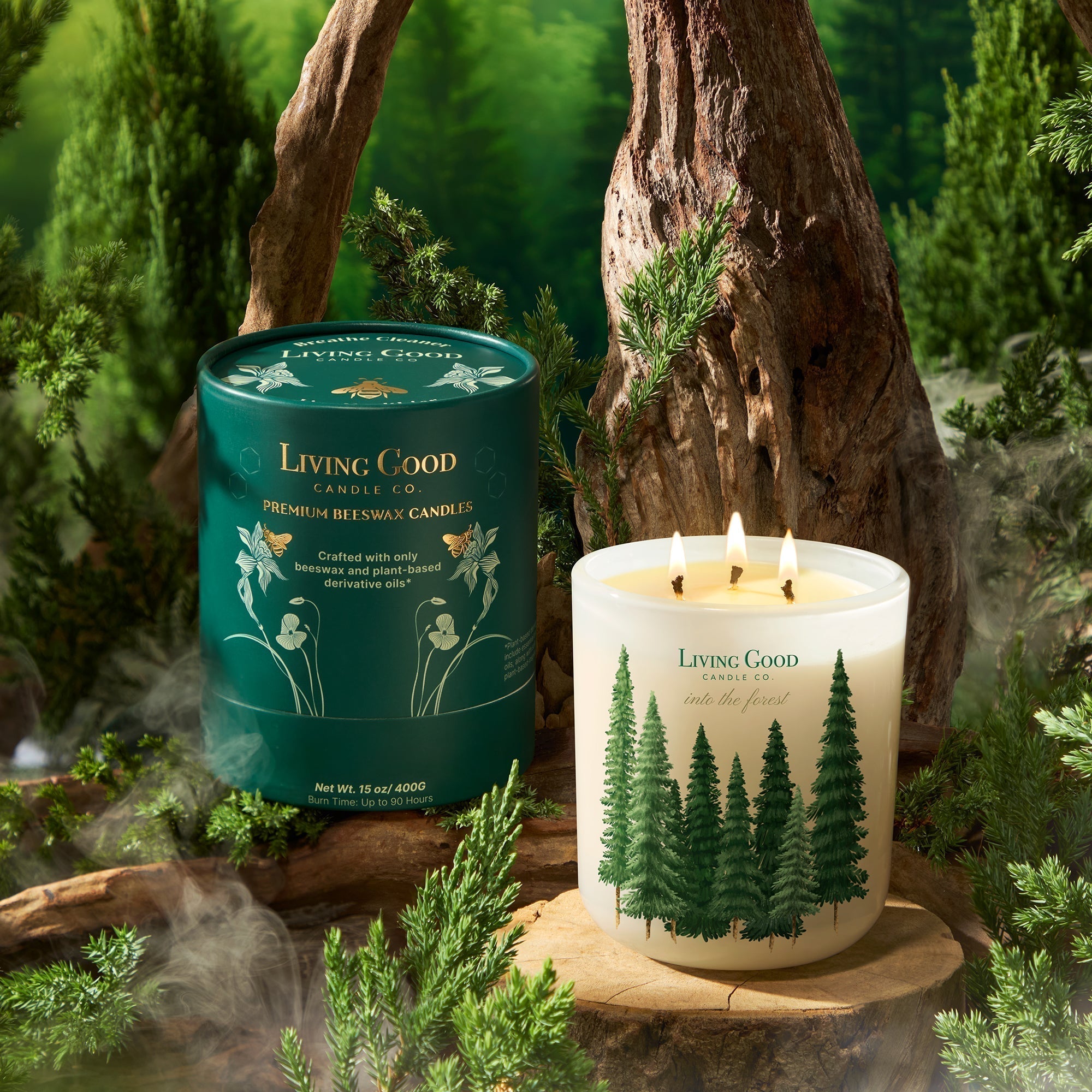
Candle Wax Showdown: Beeswax vs. Soy vs. Paraffin
When choosing a candle, you’re not just picking a scent—you’re deciding what you're breathing into your home. Most people don’t realize that the type of wax used in a candle can directly impact your health, air quality, and even your overall well-being. While paraffin, soy, and beeswax are the most common candle wax types, they are not created equal. This guide breaks down which candle wax is best for your health—and why your choice matters.
What You’ll Learn
- What Candle Wax Is Made Of And Why It Matters
- Why Candle Wax Affects Your Health
- How Paraffin Wax Impacts Indoor Air Quality And Well-Being
- The Pros And Cons Of Soy Wax Candles
- Why Beeswax Candles Are The Cleanest-Burning Option
- Which Wax Is Best For Asthma, Allergies, Or Sensitive Airways
- The Truth About Synthetic Vs. Natural Candle Fragrances
- How To Tell If A Scented Candle Is Non-Toxic
- Why Living Good Candle Co. Uses Only 100% Beeswax
- Final Verdict On The Healthiest Candle Wax
- Breathe Easy With Beeswax
What Is Candle Wax Made Of And Why It Matters
Candle wax is the fuel that holds the fragrance and keeps your candle burning. There are three main types of wax found in most candles: paraffin wax, which is derived from petroleum; soy wax, which comes from hydrogenated soybean oil; and beeswax, a natural wax made by honeybees. These different waxes not only affect how long your candle burns or how it smells—but also what it releases into the air.
Why Candle Wax Affects Your Health
Most people think about candle wax in terms of scent and aesthetics. But the real impact is what happens when that wax burns. Candles can release volatile organic compounds (VOCs), fine soot particles, and other airborne irritants into your indoor environment. These compounds affect respiratory health and may be linked to long-term health issues. People with asthma, allergies, or chemical sensitivities are especially vulnerable. If you’re burning a candle regularly, the wax you use can either support clean air—or slowly degrade it.
How Paraffin Wax Impacts Indoor Air Quality And Well-Being
Paraffin wax is one of the cheapest and most widely used candle waxes. It’s made from petroleum and is chemically bleached and deodorized before it’s shaped into candles. The problem with paraffin isn’t just its origin—it’s what it emits.
A 2009 study said that burning paraffin wax releases gases and volatile organic chemicals like toluene and benzene, which are known to cause cancer.
Source: https://www.webmd.com/balance/features/candles-health-benefits
Paraffin candles also produce black soot, which settles on your walls and furniture, and can end up in your lungs. People who burn paraffin candles regularly often complain of headaches, allergic reactions, and breathing issues. If you care about indoor air quality, paraffin should be avoided completely.
The Pros And Cons Of Soy Wax Candles
Soy wax is often considered a cleaner, greener alternative to paraffin. Made from soybeans, it burns longer and with less soot. On the surface, it seems like a better health-conscious candle choice—but that’s not always the case.
Most soy candles are made from genetically modified soybeans treated with pesticides. In addition, many are not 100% soy. Some brands blend soy wax with paraffin wax to improve scent throw and shelf life. Others add synthetic fragrance oils, which can release harmful VOCs when burned.
Another drawback is that soy requires chemical processing to be turned into wax. While soy is biodegradable, it’s not always a fully natural candle option. Even 100% soy wax can emit unwanted compounds when mixed with artificial fragrances or poor-quality ingredients.
Why Beeswax Candles Are The Cleanest-Burning Option
Beeswax candles are widely considered the cleanest-burning candles available. Beeswax is a natural byproduct of beekeeping and doesn’t require synthetic processing. It burns without releasing harmful toxins, and unlike paraffin or soy blends, it produces no soot or smoke.
What makes beeswax candles unique is their potential to improve air quality. When burned, they release negative ions, which may bind to dust, pollen, and airborne pollutants, causing them to drop from the air. People with asthma or allergies often notice an improvement in symptoms when using pure beeswax candles.
These candles are also naturally hypoallergenic. They contain no artificial dyes, no synthetic fragrance, and no chemical additives. Plus, beeswax candles have a naturally sweet honey-like scent, even when unscented. They burn longer, cleaner, and safer than both soy and paraffin alternatives.
Which Wax Is Best For Asthma, Allergies, Or Sensitive Airways
For anyone with respiratory issues, airborne sensitivities, or chemical allergies, candle wax choice is crucial. Paraffin wax can worsen asthma and emit toxins. Soy wax may still release VOCs if it’s blended or improperly scented. Beeswax candles, on the other hand, are safe, clean-burning, and gentle on sensitive lungs.
If you’re looking for the best candles for asthma, beeswax is your answer. Many users report fewer breathing problems, fewer allergy symptoms, and a noticeable difference in indoor air freshness after switching to 100% beeswax candles.
The Truth About Synthetic Vs. Natural Candle Fragrances
Fragrance can make or break a candle—but it’s also where many health concerns begin. Most commercial candles use synthetic fragrance oils, which are made from petroleum byproducts. These often contain phthalates, parabens, and other endocrine-disrupting chemicals that are released into your home when burned.
Even if a candle says “natural” on the label, it might still contain artificial fragrance. To stay safe, choose scented candles made with essential oils or plant-based derivative oils. These offer a cleaner, more natural scent and won’t compromise your air quality.
At Living Good Candle Co., we only use plant-based scents—never synthetic. Our non-toxic candles are formulated with your family’s health in mind.
How To Tell If A Scented Candle Is Non-Toxic
Many candles are labeled as “eco” or “natural,” but the ingredients tell the real story. If a candle contains paraffin, synthetic fragrance, or lacks transparency, it’s best to avoid it.
To confirm a non-toxic candle, read the label closely. Look for 100% beeswax candles, not blends. Check that the scent comes from plant-based oils, not just "fragrance." Choose wicks made from cotton or wood, and avoid anything with a metal core. A trusted brand will clearly list all ingredients and avoid misleading claims.
Why Living Good Candle Co. Uses Only 100% Beeswax
At Living Good Candle Co., we care deeply about your air quality and the health of your home. That’s why we use 100% pure beeswax in every candle—never paraffin, fillers, or artificial ingredients. Our candles are scented using plant-based derivative oils that are safe to inhale, even around babies and pets.
We also use lead-free cotton wicks and ship each order in premium, recyclable packaging that’s both environmentally friendly and beautifully designed. When you choose our candles, you’re choosing peace of mind—and a cleaner burn every time.
Final Verdict On The Healthiest Candle Wax
If your goal is to find the healthiest candle wax, the verdict is simple. Paraffin candles release harmful toxins. Soy candles are better, but only if they are 100% soy with natural fragrance. Beeswax candles are the only option that burn clean, offer natural scent, and may even improve indoor air quality.
For the cleanest, safest, and longest-burning experience, beeswax is the best candle wax for your health.
Breathe Easy With Beeswax
Candles should comfort, not compromise your wellness. If you’re lighting candles to relax or refresh your space, choose ones that actually support your health. Beeswax candles are the best non-toxic candles available—they burn longer, smell better, and keep your air clean.
At Living Good Candle Co., we make it easy to light your home with confidence. Experience the difference with a 100% beeswax candle—and breathe easier with every burn.



